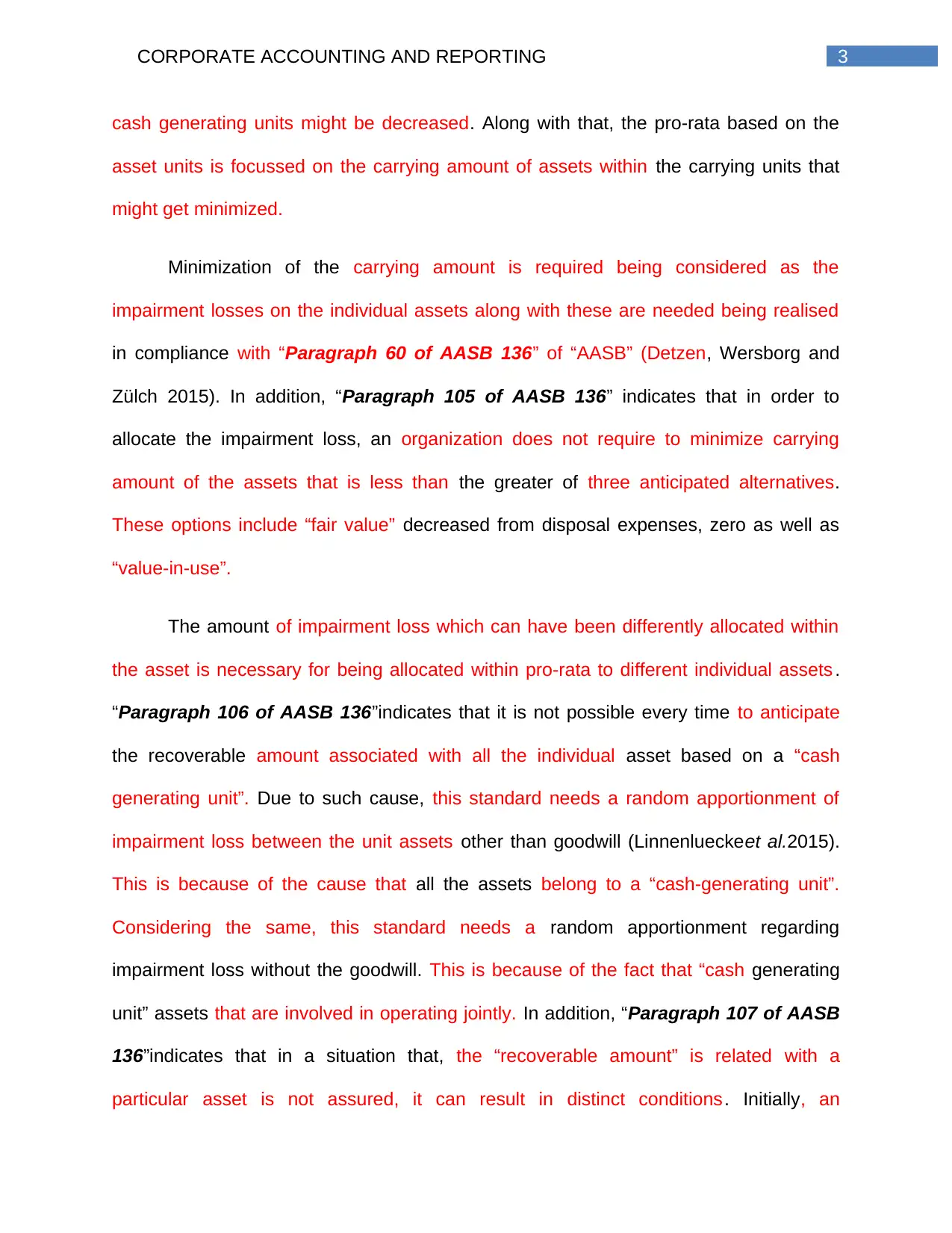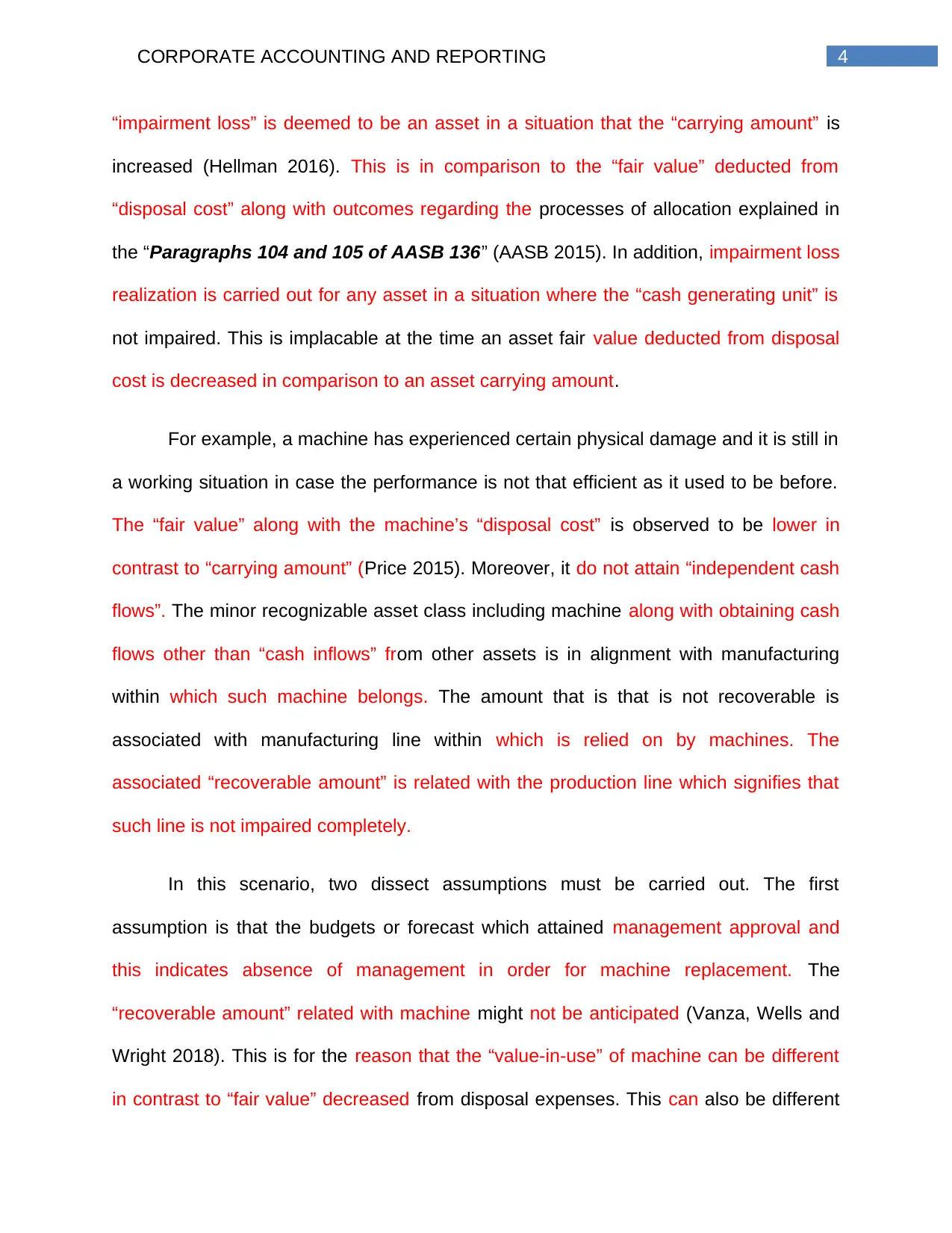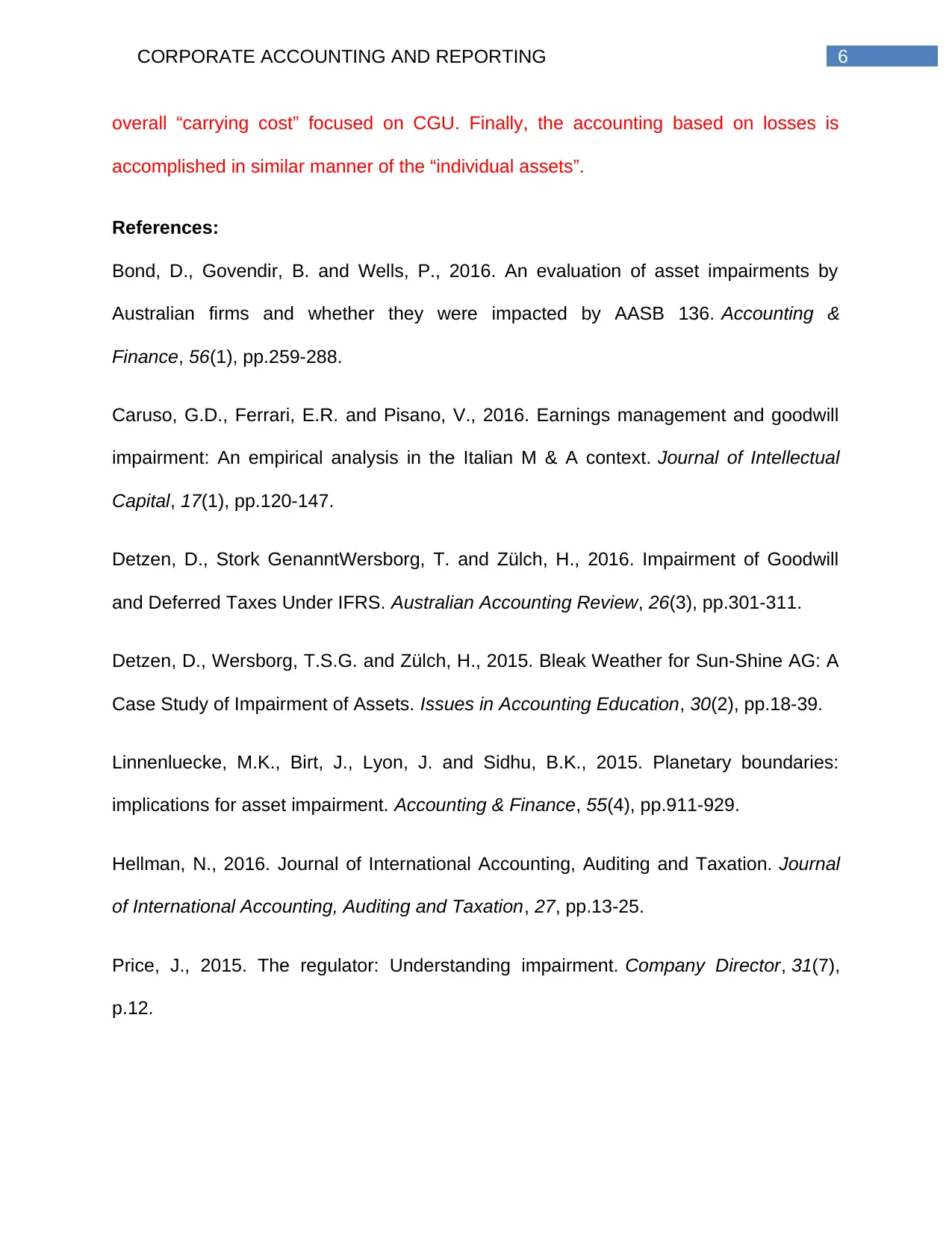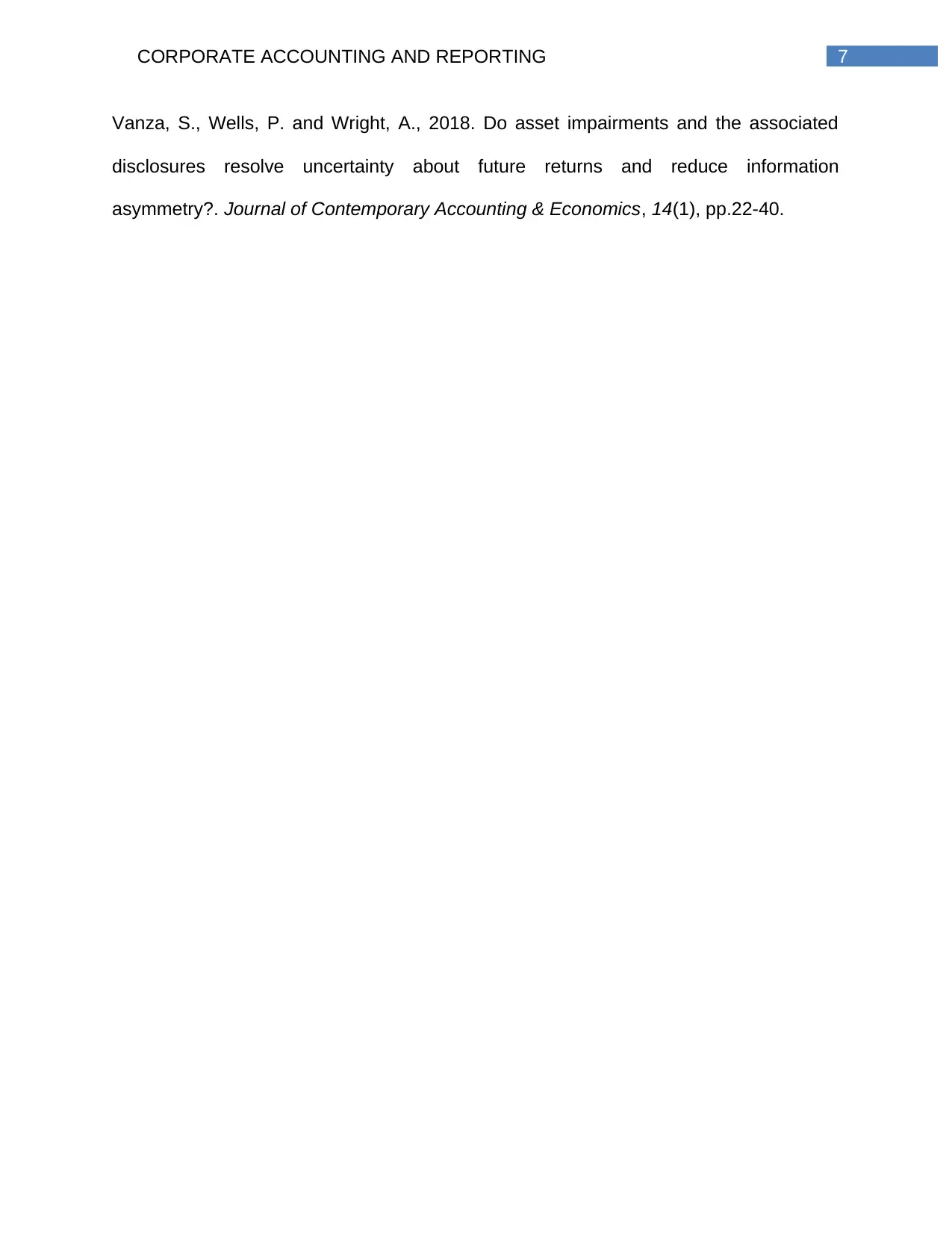University Corporate Accounting and Reporting Module Report
VerifiedAdded on 2021/06/17
|8
|1706
|21
Report
AI Summary
This report delves into the critical aspects of corporate accounting and financial reporting, with a specific focus on the impairment principle as outlined in AASB 136. The analysis centers on the concept that an asset's carrying amount should not exceed its recoverable amount, which is determined by either fair value less costs of disposal or value in use. The report explains the process of impairment testing, allocation of impairment losses, and the treatment of various asset types, including goodwill and assets within cash-generating units (CGUs). It examines how impairment losses are recognized and allocated, considering the hierarchy of asset impairment within CGUs. The report provides two scenarios for machine impairment, the first one assuming no management intent to replace the machine and the second one assuming management's intent to replace the machine by selling it. It outlines the importance of re-evaluating depreciation periods and methods and provides recommendations for organizations in managing asset impairments.

Running head: CORPORATE ACCOUNTING AND REPORTING
Corporate Accounting and Reporting
Name of the Student:
Name of the University:
Author’s Note:
Course ID:
Corporate Accounting and Reporting
Name of the Student:
Name of the University:
Author’s Note:
Course ID:
Paraphrase This Document
Need a fresh take? Get an instant paraphrase of this document with our AI Paraphraser

1CORPORATE ACCOUNTING AND REPORTING
Table of Contents
Part “A” Answer:................................................................................................................2
References:........................................................................................................................6
Table of Contents
Part “A” Answer:................................................................................................................2
References:........................................................................................................................6

2CORPORATE ACCOUNTING AND REPORTING
Part “A” Answer:
The vital objective of the impairment principle acts as an asset might not be
considered in the balance sheet rather than the recoverable amount which is increased
than the assets fair value deducted from the sell and “value in use” (Bond, Govendir and
Wells 2016). An assetcarrying amount is contrasted in comparison to the recoverable
amount and the asset is impaired in a situation where the previous is higher than the
later. Allocation of all the impairment is carried out in a situation where the impairment
loss is relied in profit or loss.
Every asset is focussed on impairment and is tested in case of impairment within
which there is an indication that impairment of all the assets are done (Caruso, Ferrari
and Pisano2016). Csonversely, there are distinct assets that includes infinite tangible
goodwill as well as assets. This is also tested for annual impairment with lack in all the
impairment indicators. Recoverable amount computation is carried out at an individual
asset level. Conversely, the assets result in the independent cash flows of several
assets. In addition, most of the assets are tested for classes of asset impairment
mentioned within the form of cash generation units.
Based on “Paragraph 104 of AASB 136”, the “impairment loss recognition” for
the “cash generating unit” can be carried out in consideration to the amount recoverable
associated with the unit is decreased in contrast to the units carrying amount (Detzen,
Stork Genannt Wersborg and Zülch 2016). “Impairment loss” allocation is carried out in
for reducing an asset’s “carrying amount” regarding the units in two chronological
orders. Firstly, the carrying amount which is related with goodwill and associated with
Part “A” Answer:
The vital objective of the impairment principle acts as an asset might not be
considered in the balance sheet rather than the recoverable amount which is increased
than the assets fair value deducted from the sell and “value in use” (Bond, Govendir and
Wells 2016). An assetcarrying amount is contrasted in comparison to the recoverable
amount and the asset is impaired in a situation where the previous is higher than the
later. Allocation of all the impairment is carried out in a situation where the impairment
loss is relied in profit or loss.
Every asset is focussed on impairment and is tested in case of impairment within
which there is an indication that impairment of all the assets are done (Caruso, Ferrari
and Pisano2016). Csonversely, there are distinct assets that includes infinite tangible
goodwill as well as assets. This is also tested for annual impairment with lack in all the
impairment indicators. Recoverable amount computation is carried out at an individual
asset level. Conversely, the assets result in the independent cash flows of several
assets. In addition, most of the assets are tested for classes of asset impairment
mentioned within the form of cash generation units.
Based on “Paragraph 104 of AASB 136”, the “impairment loss recognition” for
the “cash generating unit” can be carried out in consideration to the amount recoverable
associated with the unit is decreased in contrast to the units carrying amount (Detzen,
Stork Genannt Wersborg and Zülch 2016). “Impairment loss” allocation is carried out in
for reducing an asset’s “carrying amount” regarding the units in two chronological
orders. Firstly, the carrying amount which is related with goodwill and associated with
⊘ This is a preview!⊘
Do you want full access?
Subscribe today to unlock all pages.

Trusted by 1+ million students worldwide

3CORPORATE ACCOUNTING AND REPORTING
cash generating units might be decreased. Along with that, the pro-rata based on the
asset units is focussed on the carrying amount of assets within the carrying units that
might get minimized.
Minimization of the carrying amount is required being considered as the
impairment losses on the individual assets along with these are needed being realised
in compliance with “Paragraph 60 of AASB 136” of “AASB” (Detzen, Wersborg and
Zülch 2015). In addition, “Paragraph 105 of AASB 136” indicates that in order to
allocate the impairment loss, an organization does not require to minimize carrying
amount of the assets that is less than the greater of three anticipated alternatives.
These options include “fair value” decreased from disposal expenses, zero as well as
“value-in-use”.
The amount of impairment loss which can have been differently allocated within
the asset is necessary for being allocated within pro-rata to different individual assets .
“Paragraph 106 of AASB 136”indicates that it is not possible every time to anticipate
the recoverable amount associated with all the individual asset based on a “cash
generating unit”. Due to such cause, this standard needs a random apportionment of
impairment loss between the unit assets other than goodwill (Linnenlueckeet al.2015).
This is because of the cause that all the assets belong to a “cash-generating unit”.
Considering the same, this standard needs a random apportionment regarding
impairment loss without the goodwill. This is because of the fact that “cash generating
unit” assets that are involved in operating jointly. In addition, “Paragraph 107 of AASB
136”indicates that in a situation that, the “recoverable amount” is related with a
particular asset is not assured, it can result in distinct conditions. Initially, an
cash generating units might be decreased. Along with that, the pro-rata based on the
asset units is focussed on the carrying amount of assets within the carrying units that
might get minimized.
Minimization of the carrying amount is required being considered as the
impairment losses on the individual assets along with these are needed being realised
in compliance with “Paragraph 60 of AASB 136” of “AASB” (Detzen, Wersborg and
Zülch 2015). In addition, “Paragraph 105 of AASB 136” indicates that in order to
allocate the impairment loss, an organization does not require to minimize carrying
amount of the assets that is less than the greater of three anticipated alternatives.
These options include “fair value” decreased from disposal expenses, zero as well as
“value-in-use”.
The amount of impairment loss which can have been differently allocated within
the asset is necessary for being allocated within pro-rata to different individual assets .
“Paragraph 106 of AASB 136”indicates that it is not possible every time to anticipate
the recoverable amount associated with all the individual asset based on a “cash
generating unit”. Due to such cause, this standard needs a random apportionment of
impairment loss between the unit assets other than goodwill (Linnenlueckeet al.2015).
This is because of the cause that all the assets belong to a “cash-generating unit”.
Considering the same, this standard needs a random apportionment regarding
impairment loss without the goodwill. This is because of the fact that “cash generating
unit” assets that are involved in operating jointly. In addition, “Paragraph 107 of AASB
136”indicates that in a situation that, the “recoverable amount” is related with a
particular asset is not assured, it can result in distinct conditions. Initially, an
Paraphrase This Document
Need a fresh take? Get an instant paraphrase of this document with our AI Paraphraser

4CORPORATE ACCOUNTING AND REPORTING
“impairment loss” is deemed to be an asset in a situation that the “carrying amount” is
increased (Hellman 2016). This is in comparison to the “fair value” deducted from
“disposal cost” along with outcomes regarding the processes of allocation explained in
the “Paragraphs 104 and 105 of AASB 136” (AASB 2015). In addition, impairment loss
realization is carried out for any asset in a situation where the “cash generating unit” is
not impaired. This is implacable at the time an asset fair value deducted from disposal
cost is decreased in comparison to an asset carrying amount.
For example, a machine has experienced certain physical damage and it is still in
a working situation in case the performance is not that efficient as it used to be before.
The “fair value” along with the machine’s “disposal cost” is observed to be lower in
contrast to “carrying amount” (Price 2015). Moreover, it do not attain “independent cash
flows”. The minor recognizable asset class including machine along with obtaining cash
flows other than “cash inflows” from other assets is in alignment with manufacturing
within which such machine belongs. The amount that is that is not recoverable is
associated with manufacturing line within which is relied on by machines. The
associated “recoverable amount” is related with the production line which signifies that
such line is not impaired completely.
In this scenario, two dissect assumptions must be carried out. The first
assumption is that the budgets or forecast which attained management approval and
this indicates absence of management in order for machine replacement. The
“recoverable amount” related with machine might not be anticipated (Vanza, Wells and
Wright 2018). This is for the reason that the “value-in-use” of machine can be different
in contrast to “fair value” decreased from disposal expenses. This can also be different
“impairment loss” is deemed to be an asset in a situation that the “carrying amount” is
increased (Hellman 2016). This is in comparison to the “fair value” deducted from
“disposal cost” along with outcomes regarding the processes of allocation explained in
the “Paragraphs 104 and 105 of AASB 136” (AASB 2015). In addition, impairment loss
realization is carried out for any asset in a situation where the “cash generating unit” is
not impaired. This is implacable at the time an asset fair value deducted from disposal
cost is decreased in comparison to an asset carrying amount.
For example, a machine has experienced certain physical damage and it is still in
a working situation in case the performance is not that efficient as it used to be before.
The “fair value” along with the machine’s “disposal cost” is observed to be lower in
contrast to “carrying amount” (Price 2015). Moreover, it do not attain “independent cash
flows”. The minor recognizable asset class including machine along with obtaining cash
flows other than “cash inflows” from other assets is in alignment with manufacturing
within which such machine belongs. The amount that is that is not recoverable is
associated with manufacturing line within which is relied on by machines. The
associated “recoverable amount” is related with the production line which signifies that
such line is not impaired completely.
In this scenario, two dissect assumptions must be carried out. The first
assumption is that the budgets or forecast which attained management approval and
this indicates absence of management in order for machine replacement. The
“recoverable amount” related with machine might not be anticipated (Vanza, Wells and
Wright 2018). This is for the reason that the “value-in-use” of machine can be different
in contrast to “fair value” decreased from disposal expenses. This can also be different

5CORPORATE ACCOUNTING AND REPORTING
decreased from “disposal costs” as well as this might be made sure for CGU within
which the machine is related with. For such cause, there is no realization of “impairment
loss” focussed on machine. Considering same, this is important for the organization for
depreciation period re-evaluation along with the method of depreciation associated with
the machine. This is also recommended to the organization regarding implementation of
less depreciation period or rapid depreciation method. This is in order to indicate the
existing life related with the machine or the way in which the advantages are estimated
to be utilised.
The second assumption is considered to be the budgets or estimations which
attained proper management approval indicates its intention in replacing the machine by
means of selling the same in the upcoming years. Such “cash inflows” from continuous
utilization of the machine till its disposal is indicated to be decreased. In this condition,
the “value in use” associated with machine cannot be anticipated as near to the fair
value subtracted from “disposal cost”. Therefore, it is not deemed to be ensured that the
recoverable amount is linked with machine. For this for the reason that, there is lack of
any consideration within “cash generating unit” within which this machine is associated
and that remains in production line. Considering that the “fair value” decreased from
“disposal cost” of a machine that is decreased in comparison to the “carrying amount”
and the “impairment loss” is realised focussed on related machine.
Relied on previous explanation, it might be indicated that at the time of the
impairment loss takes place within CGU other than goodwill. Such loss is also
apportioned all over the assets in CGU focussed on pro-rata that is linked with the
decreased from “disposal costs” as well as this might be made sure for CGU within
which the machine is related with. For such cause, there is no realization of “impairment
loss” focussed on machine. Considering same, this is important for the organization for
depreciation period re-evaluation along with the method of depreciation associated with
the machine. This is also recommended to the organization regarding implementation of
less depreciation period or rapid depreciation method. This is in order to indicate the
existing life related with the machine or the way in which the advantages are estimated
to be utilised.
The second assumption is considered to be the budgets or estimations which
attained proper management approval indicates its intention in replacing the machine by
means of selling the same in the upcoming years. Such “cash inflows” from continuous
utilization of the machine till its disposal is indicated to be decreased. In this condition,
the “value in use” associated with machine cannot be anticipated as near to the fair
value subtracted from “disposal cost”. Therefore, it is not deemed to be ensured that the
recoverable amount is linked with machine. For this for the reason that, there is lack of
any consideration within “cash generating unit” within which this machine is associated
and that remains in production line. Considering that the “fair value” decreased from
“disposal cost” of a machine that is decreased in comparison to the “carrying amount”
and the “impairment loss” is realised focussed on related machine.
Relied on previous explanation, it might be indicated that at the time of the
impairment loss takes place within CGU other than goodwill. Such loss is also
apportioned all over the assets in CGU focussed on pro-rata that is linked with the
⊘ This is a preview!⊘
Do you want full access?
Subscribe today to unlock all pages.

Trusted by 1+ million students worldwide

6CORPORATE ACCOUNTING AND REPORTING
overall “carrying cost” focused on CGU. Finally, the accounting based on losses is
accomplished in similar manner of the “individual assets”.
References:
Bond, D., Govendir, B. and Wells, P., 2016. An evaluation of asset impairments by
Australian firms and whether they were impacted by AASB 136. Accounting &
Finance, 56(1), pp.259-288.
Caruso, G.D., Ferrari, E.R. and Pisano, V., 2016. Earnings management and goodwill
impairment: An empirical analysis in the Italian M & A context. Journal of Intellectual
Capital, 17(1), pp.120-147.
Detzen, D., Stork GenanntWersborg, T. and Zülch, H., 2016. Impairment of Goodwill
and Deferred Taxes Under IFRS. Australian Accounting Review, 26(3), pp.301-311.
Detzen, D., Wersborg, T.S.G. and Zülch, H., 2015. Bleak Weather for Sun-Shine AG: A
Case Study of Impairment of Assets. Issues in Accounting Education, 30(2), pp.18-39.
Linnenluecke, M.K., Birt, J., Lyon, J. and Sidhu, B.K., 2015. Planetary boundaries:
implications for asset impairment. Accounting & Finance, 55(4), pp.911-929.
Hellman, N., 2016. Journal of International Accounting, Auditing and Taxation. Journal
of International Accounting, Auditing and Taxation, 27, pp.13-25.
Price, J., 2015. The regulator: Understanding impairment. Company Director, 31(7),
p.12.
overall “carrying cost” focused on CGU. Finally, the accounting based on losses is
accomplished in similar manner of the “individual assets”.
References:
Bond, D., Govendir, B. and Wells, P., 2016. An evaluation of asset impairments by
Australian firms and whether they were impacted by AASB 136. Accounting &
Finance, 56(1), pp.259-288.
Caruso, G.D., Ferrari, E.R. and Pisano, V., 2016. Earnings management and goodwill
impairment: An empirical analysis in the Italian M & A context. Journal of Intellectual
Capital, 17(1), pp.120-147.
Detzen, D., Stork GenanntWersborg, T. and Zülch, H., 2016. Impairment of Goodwill
and Deferred Taxes Under IFRS. Australian Accounting Review, 26(3), pp.301-311.
Detzen, D., Wersborg, T.S.G. and Zülch, H., 2015. Bleak Weather for Sun-Shine AG: A
Case Study of Impairment of Assets. Issues in Accounting Education, 30(2), pp.18-39.
Linnenluecke, M.K., Birt, J., Lyon, J. and Sidhu, B.K., 2015. Planetary boundaries:
implications for asset impairment. Accounting & Finance, 55(4), pp.911-929.
Hellman, N., 2016. Journal of International Accounting, Auditing and Taxation. Journal
of International Accounting, Auditing and Taxation, 27, pp.13-25.
Price, J., 2015. The regulator: Understanding impairment. Company Director, 31(7),
p.12.
Paraphrase This Document
Need a fresh take? Get an instant paraphrase of this document with our AI Paraphraser

7CORPORATE ACCOUNTING AND REPORTING
Vanza, S., Wells, P. and Wright, A., 2018. Do asset impairments and the associated
disclosures resolve uncertainty about future returns and reduce information
asymmetry?. Journal of Contemporary Accounting & Economics, 14(1), pp.22-40.
Vanza, S., Wells, P. and Wright, A., 2018. Do asset impairments and the associated
disclosures resolve uncertainty about future returns and reduce information
asymmetry?. Journal of Contemporary Accounting & Economics, 14(1), pp.22-40.
1 out of 8
Related Documents
Your All-in-One AI-Powered Toolkit for Academic Success.
+13062052269
info@desklib.com
Available 24*7 on WhatsApp / Email
![[object Object]](/_next/static/media/star-bottom.7253800d.svg)
Unlock your academic potential
Copyright © 2020–2025 A2Z Services. All Rights Reserved. Developed and managed by ZUCOL.



